Author: Jennifer Hallock
Sugar Sun series glossary term #31: banca (bangka) (but really this is the post on language)
The Definition
What is a bangka? It depends on whom you ask.
Javier was not thrilled to be out on the water at such a late hour, even if the moon was bright and the rowers competent. Had this been a pleasure tour, the hacendero would have had no complaint, but tonight he wanted to get on with it or go home. As if they could read Javier’s mind, the rowers abruptly beached the banca, hopped out onto shore, and dragged the vessels away from the water line.
As you can probably guess from the context, banca or bangka means boat—specifically a double-outrigger canoe. If you have visited anywhere outside Manila, you have probably taken a bangka. When I first drafted Sugar Moon, Ben and Allie did a fair amount of bangka travel in Samar.
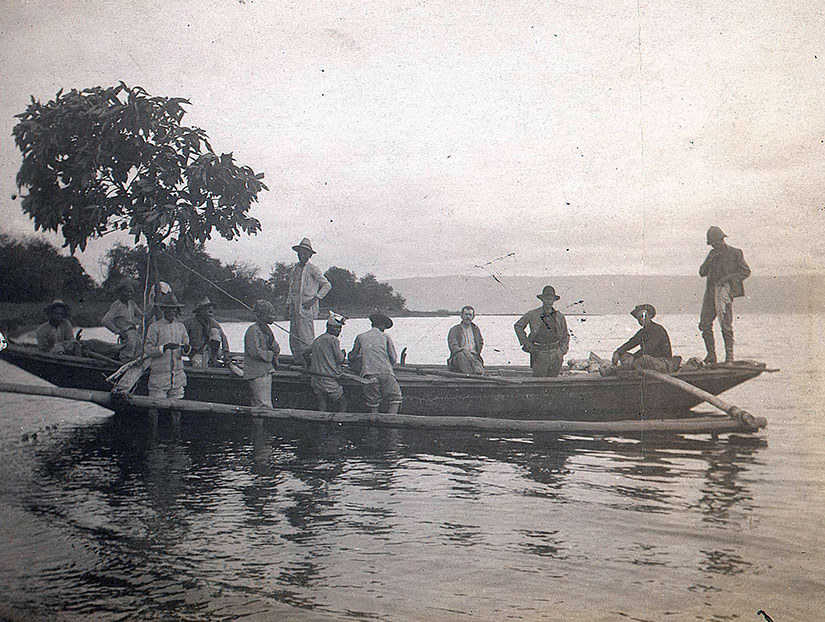
But here’s the problem: bangka may mean outrigger canoe in Tagalog and Cebuano, but I found out that it means cockroach in the Waray language of Samar, Biliran, and parts of Leyte. While strange stuff happens in Sugar Moon, riding a cockroach through the surf is a whole new level. So I took the word out and used boring old English.
The Implication
This brings up an important point about the Philippines: it the tenth most linguistically diverse country in the world. There are eight language groups, 19 local languages that can be taught in early childhood education (from kindergarten to 3rd grade), and now 200 total languages identified. Such linguistic abundance makes geographic sense. The Philippines is an archipelago nation of 7,641 islands, and it is so spread out that it stretches almost from Seattle to Los Angeles. No wonder one language could not dominate. But this doesn’t make things easy.
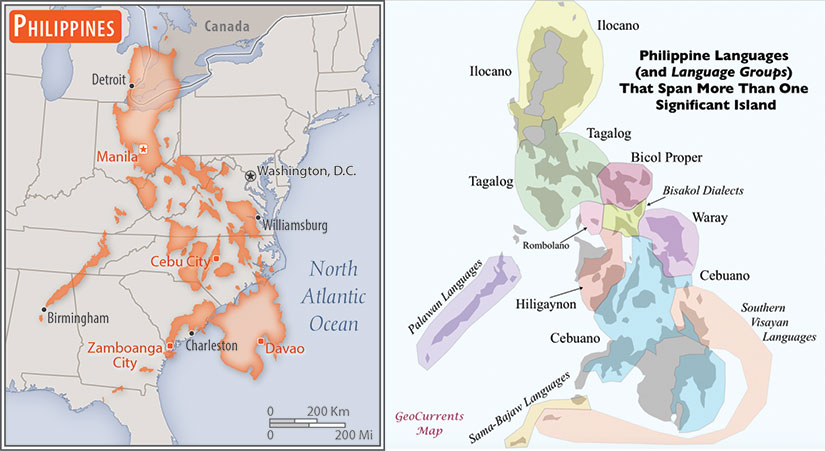
As you may remember from previous posts, the Americans turned this rich multilingual heritage into a justification for a monolingual (English) education system. English is still one of the two official languages of the country, along with Filipino. (Filipino is the “most prestigious variety” of the Tagalog language of Metro Manila, according to the chair of the Komisyon sa Wikang Filipino, or the Commission on the Filipino Language.)
For the purposes of my series, Filipino (or Tagalog) had not yet been designated official (1937), which means that regional languages, such as those in the Visayas (like Cebuano and Waray) would have been even stronger at the beginning of the twentieth century. I have to thank Liana Smith Bautista (and her mom) for being my newest go-to research sources on Cebuano, though all errors in my books are my own. I also am deeply indebted to the creator of the amazing Binisaya online dictionary and reference guide.
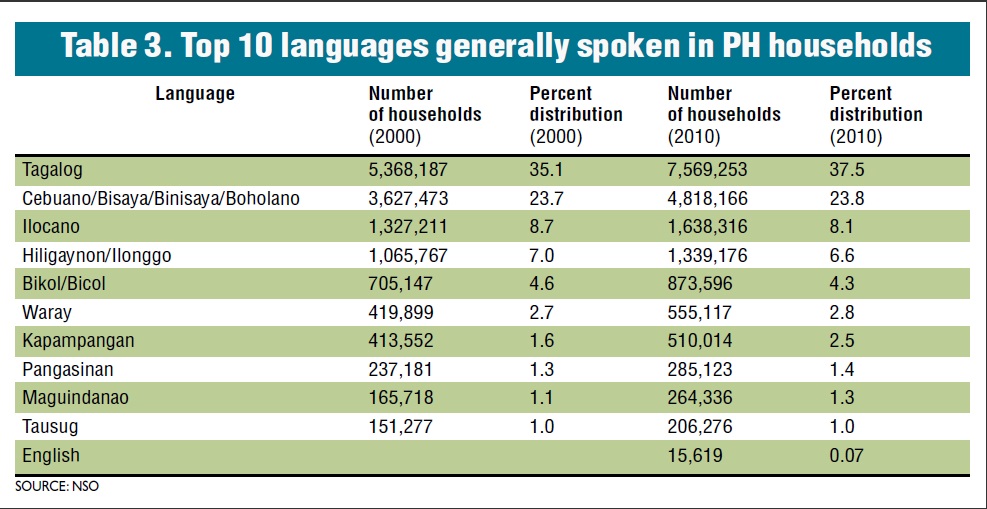
American readers, have I utterly confused you? The number of indigenous languages is daunting—and I have not even mentioned the foreign tongues spoken in some families, like Hokkien (from China). Is it any surprise that most Filipinos grow up bilingual, at the very least? As Javier said to Georgina when they first argued about her English textbooks: “I grew up bilingual, learned three more languages in school, and another while traveling. It’s only Americans who can’t seem to manage more than one.” (And with the direction of funding for foreign language education in US public schools, we will not be getting much better.)
Allegra is a polyglot, too, by the way:
“To be honest, it’s a little eerie how fluent you are. From what the folks here tell me, you also speak Spanish like an Iberian. And Cebuano, and Tagalog, and Latin . . .”
She used her free hand to wave away the compliment. “I grew up speaking Spanish in the house and Cebuano in town—and then Tagalog in Manila. No one but a priest speaks Latin, but I learned to read it in school—”
“You’re missing my point. You’re a linguist, a natural. If you study for the rest of this test with Allegra-like persistence—and maybe a little un-Allegra-like humility—I have no doubt you’ll pass next time.”
She blushed even more furiously than when he had first taken her hand. “Thank you.”
— Sugar Moon (upcoming)
Ben’s respect for Allegra’s intelligence has been one of the most fun things about writing this couple. He is not a scholar and doesn’t pretend to be, but he is not intimidated by her skills, either. In fact, as we’ll see, he needs them.
So we’ve gotten a little bit away from the bangka in this glossary “definition”—sorry—but you probably just needed a picture for that. (If you want more nautical know-how, read about this group trying to help local fishermen design bangkas out of fiberglass—a light, durable, super-typhoon-proof alternative to wood.) Otherwise, I hope that you, like me, have learned a larger lesson about language through the study of this one little word.

EDITED TO ADD: Bangka is also a verb! This is from Liana: “Also it’s to be noted that in Bisaya, bangka with a hard stress on the final syllable refers to a type of boat, but keep the pronunciation soft and it is a verb meaning to treat someone out (usually to a meal, but can be used in other contexts where you pay for another person’s fare, lodging, etc.). It’s not uncommon for my cousins to say ‘bangkahi ko, beh?’ (Won’t you treat me?) when we talk of going to lunch or seeing a movie, for example.”
Sugar Sun series glossary term #33: water cure
I spend a lot of time writing about the good stuff, like sex on traditional Philippine furniture. (For example, here and here.) But my blog is not all fun and games. I have set my novels in the Philippine-American War, and that was a horrible war. I have posted before on how the war began, how it was conducted, and a little bit about battles and operations—but I have avoided this particular post for a long time. This is the post on the water cure.
If you’re not feeling like anything disturbing, heavy, or possibly enraging, do go check out those other posts about sexy times on antique furniture. Come back to this another time.
Warning: If you do choose to stay, please note that this post discusses a practice at least partly motivated by racism. A few of the historic sources include racist language or judgments.
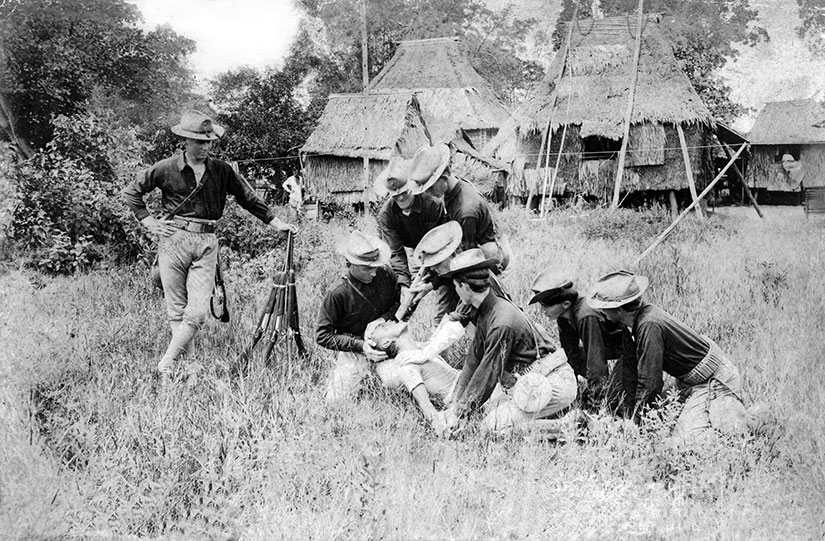
The water cure is a little different than modern-day waterboarding. In waterboarding, water is poured over a cloth covering the face to simulate the sensation of drowning. That may seem like it’s some sort of fake out, but it does cause real injuries. The water cure, though, is even more physical. In this practice, they laid a prisoner on his back, stood another man on each hand and foot, and forced a hollow tube into the victim’s throat. Through the tube they poured an entire pail of saltwater, dished up with a little sand to inflict a more severe punishment. When the prisoner did not give up, they poured in another pailful. Once the unlucky victim’s belly was “distended to the point of bursting,” a soldier would “tap” it with the butt of his gun. If the water did not spout high enough, they would jump up and down on his stomach. In the words of A. F. Miller of the 32nd Volunteer Infantry Regiment: “They swell[ed] up like toads. I’ll tell you it [was] a terrible torture.”
According to historian Darius Rejali, “Even a small amount of water in the glottis causes violent coughing, initiating a fight-or-flight response…triggering desperate efforts to break free. The supply of oxygen…is exhausted within seconds. While this is sometimes called ‘an illusion of drowning,’ the reality is that death will follow if the procedure is not stopped in time.” And it did.

This cruel technique was first introduced in the Spanish Inquisition and then spread throughout medieval Europe. The Spanish brought it to the Philippines, trained local scouts in the practice, and then those scouts taught the American soldiers. Some soldiers were more eager than others to use it. Major Edwin Glenn and “Glenn’s Brigade” were infamous for water curing thirteen priests of Samar—half of the clergy on the island—and they even killed one of the priests in the process. This was a part of the “howling wilderness” period.
When the American public found out about what Glenn had been up to in the islands, he was court-martialed. Actually, Glenn was brought to court three times. The first time he was found guilty of uncivilized conduct in war, despite his claims that the water cure could be a remedy for dengue fever. (Yes, he really did try that excuse. He even called witnesses to testify to this. It’s in the 1902 archives of the Manila Times.) He was given a one-month suspension and fined fifty dollars. (In comparison, the man he water-cured that time, the mayor of Igbaras in Iloilo, was sentenced to ten years hard labor for what he was confessed under duress.) Glenn was court-martialed a second time for killing seven prisoners of war, though he was acquitted. Finally, he was sued in civil court for $15,000 (over $420,000 in 2016 dollars) by a former revolutionary named Calda. I have never found out how this last case ended, but I do appreciate the hutzpah that encouraged it. Since Glenn retired as a brigadier general from the Army, I can assume that nothing stuck.
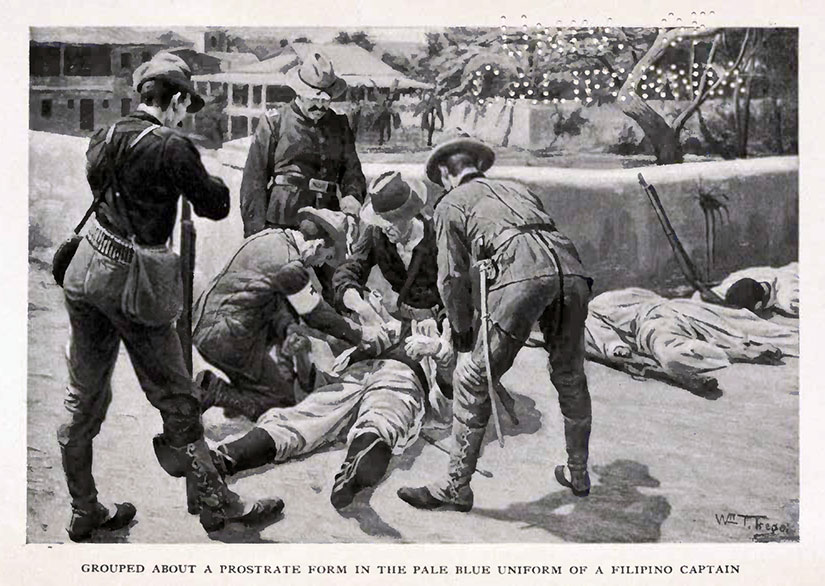
Stories like the ones about Glenn’s Brigade were said to have “covered with a foul blot the flag which we all love and honor” by Senator Hoar (R) of Massachusetts. This led to an official inquiry in the Senate by the Committee on the Philippines. The discussion was fractious. Henry Cabot Lodge, another Republican senator from Massachusetts, chaired the committee—not because he wanted to uncover atrocities, but because he wanted to steer the committee away from doing any such thing. (Yes, two senators from the same state and the same party were sworn enemies on this issue.)
Lodge, in particular, did not want to criticize anything that soldiers did in the name of empire. He said that the water cure had:
…grown out of the conditions of warfare, of the war that was waged by the Filipinos themselves, a semicivilized people, with all the tendencies and characteristics of Asiatics, with the Asiatic indifference to life, with the Asiatic treachery and the Asiatic cruelty, all tinctured and increased by three hundred years of subjection to Spain.
Way to pass the buck, dude. (I’d like to remind readers that the water cure originated in Europe, not Asia.)
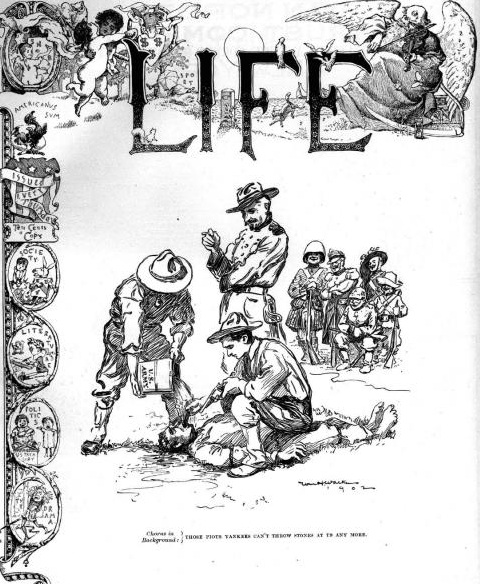
Despite Senator Lodge’s and Senator’s Beveridge’s (R-IN) staunch support of “military necessity,” soldiers did testify to atrocities they witnessed in the Philippines. Even Lt. General Nelson A. Miles told the Secretary of War that the conflict had been fought with “marked severity.” The evidence, and Miles’s remarks, were printed in the newspapers across the United States.
Novelist and prominent anti-imperialist Mark Twain wrote about the hypocrisy of Americans fighting a war to “civilize” another country and then succumbing to the very barbarism they sought to expunge. His essay “To the Person Sitting in Darkness” is one of his best and most biting pieces of satire:
The Person Sitting in Darkness is almost sure to say: “There is something curious about this — curious and unaccountable. There must be two Americas: one that sets the captive free, and one that takes a once-captive’s new freedom away from him, and picks a quarrel with him with nothing to found it on; then kills him to get his land.” …And as for a flag for the Philippine Province, it is easily managed. We can have a special one — our States do it: we can have just our usual flag, with the white stripes painted black and the stars replaced by the skull and cross-bones.
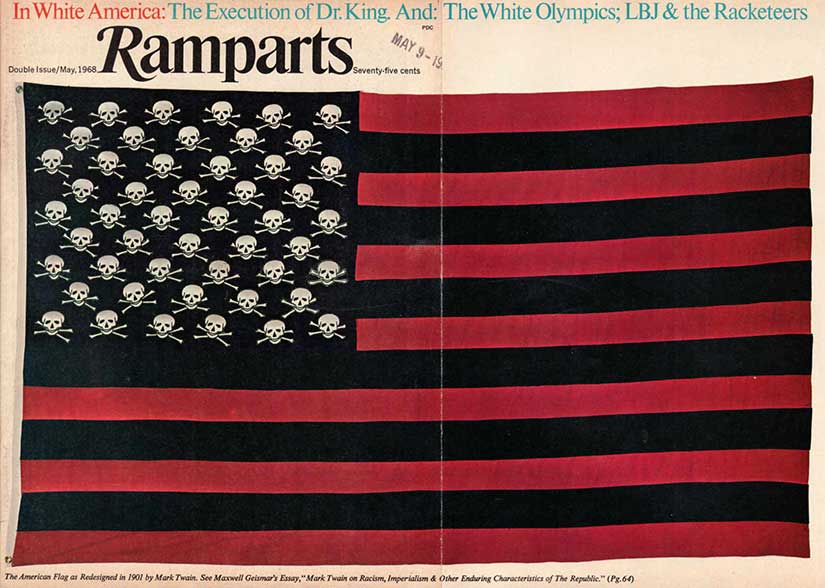
In the midst of the 1902 crisis, President Theodore Roosevelt tried to limit the damage to blaming a few weak men:
The temptation to retaliate for the fearful cruelties of a savage foe is very great, and now and then it has been yielded to. There have been a few, and only a few, such instances in the Philippines, and punishment has been meted out with unflinching justice to the offenders.
But was this truly just a few bad apples? Certainly, many of the soldiers knew of the practice. They even sang songs to it.
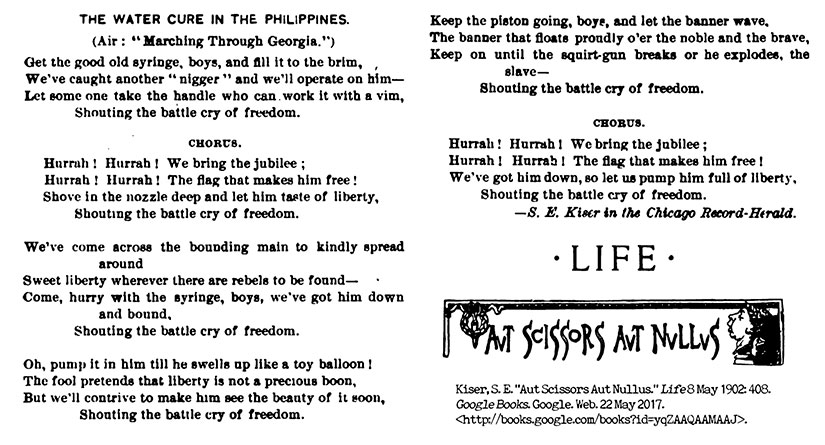
The commanders in the field knew better than to underestimate the problem. In 1903, an expedition in Surigao declared:
…let there be no water curing or severity that is not plainly authorized without straining interpretations of [the] law of war… .Anyone who disgraces our uniform by engaging in such barbarous practices will be punished on the spot… .Success will not be marred by any well founded complaints of undue severity and flagrant misconduct.
What does this prove? That seventy years before Vietnam and one hundred years before Iraq, there was a national conversation about how America should exercise its authority abroad. Unfortunately, though, nothing was concluded. The controversy was quelled by a conveniently timed declaration of “peace” in the islands on July 4, 1902. (It was not peace, though: fighting would continue until 1913, including other, bigger atrocities, like the hundreds of civilian dead at Bud Dajo.)
When the military handed power over to a civil government under Governor William Howard Taft, Americans at home believed their problems were solved. However, because America did not finish the conversation, the public was forced to have it all over again in 1969 (when the My Lai massacre story broke) and in 2004 (when the Abu Ghraib torture and prisoner abuse scandal broke). Does the end always justify the means? What if the means makes the end goal—peace—impossible? Unfortunately, Americans may be tiring of these questions before they can come to a consensus about the answers.
The administration of President Donald J. Trump has recently declared its intention to hide a 2014 report describing the CIA’s harsh detention and interrogation programs. By returning the document to Congress, this shields the report from ever being accessible to the American public through the Freedom of Information Act. Throwing this 6700-page report down the memory hole has more of a precedent than we would like to think. We’ve forgotten before.
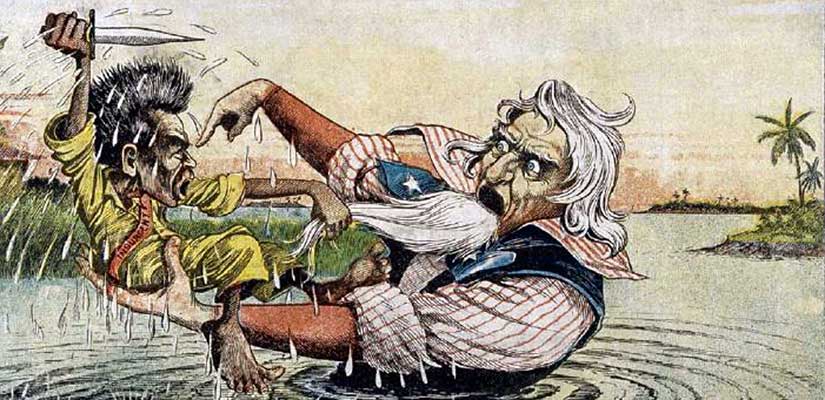
The Business Workshops of #RT17
Last week, I told you a bit about the craft workshops and panels I attended at #RT17. This week, I’m all business. This is long, so you might want to digest it in chunks.

This workshop was led by Smashwords founder Mark Coker. You can read a comprehensive recap of all ten trends at author Cecilia Tan’s blog here, and most of it you already know: digital publishing has democratized publishing; romance has led the way in professional-quality independent publishing; and that there is a glut of high quality, low-priced books. The ability to inventory digital books for basically free means that everything stays in print and on the market forever. This increased supply has pushed down prices, especially for new authors.
Coker ended the presentation with a call for author mobilization against KDP Select, Amazon’s exclusivity program with subscription-based pricing. He portrayed KDP’s system as predatory pricing, a monopolistic practice that threatens to put Amazon’s competitors out of business. This threatens the newly-found independence and choice of independent authors. We have just been released from bondage to the Big Five, and now we’re in bondage to Amazon, according to Coker. While this may be true, he did not fully recognize the prisoner’s dilemma that Amazon presents to authors. If we all stood up together as one and refused to participate in KDP, we would all be punished equally by Amazon’s algorithm—meaning none of us would be punished. This might put KDP out of business. But without collective action, pulling out of KDP will only hurt the individual author who takes the stand. Your books will be buried in Amazon, and other authors will be thrilled to take your spot at the top of the bestseller lists. In this prisoner’s dilemma, no one chooses the collective good over their own self-interest. That’s human nature, and Amazon knows it.

This presentation was less ideological and more data-driven than the first. Some of the data followed the trends seen in his 2016 survey, but let me recap what I found particularly interesting. Note that all of this is based on averages, so your mileage may vary. The survey showed that among his authors:
- Write as long as you need to. The top 70 bestselling romance authors at Smashwords average 92,000 words (excluding box sets) and 113,000 words (including box sets).
- But keep the titles short. The top 100 bestsellers at Smashwords have 24.45 characters on average in the title, while the 900-1000 bestsellers have 30.11 characters on average. The last 100 surveyed (bestsellers 9,900-10,000) average 35.5 characters.
- How much should you charge for your ebooks? Free books still get the most downloads, but among books for sale, the best range is still from $2.99-$4.99. The spot at $1.99 is a dead zone. It seems to be better for Smashwords authors to price at $0.99 or $2.99 than $1.99.
- If you write a series—and, yes, they still dominate the romance market—you should give away the starter for free. 7 out of 10 of the bestselling series on Smashwords have a free starter. Interestingly, 4 of the 10 did not have any new book in the series published within the survey period (a year), which shows the persistence of series, even when complete or on pause.
- Should you put your books up for preorder? Especially in the iBooks store, yes. They count your preorders as first day sales, unlike Amazon where they are counted on the day the purchase is made. Coker found that of the top 1000 bestselling authors, 61.7% released at least one book on preorder. There could be other factors at work, like the fact that the most professional and organized authors might be the one getting their act together for preorders. Maybe they have nicer covers, better writing, and better advance marketing, he suggested.
- Should you do a box set? “Box sets are not the path to riches, but they can be a nice complement to your publishing strategy,” Coker said. Authors participating in at least one box set—whether alone or with other authors—are highly represented among bestselling authors. However, in my opinion, this may be more a function of catalog size than actual box set sales. Authors with more books in the backlist tend to have higher earnings and more followers, and these are the authors who have the material to create a box set. Moreover, the best selling box sets are $0.99, which is a pretty low value on that many words.

This workshop featured two executives of Written Word Media, the team behind FreeBooksy and Bargain Booksy. It was a little free-form, but here are the takeaways that I think may interest fellow authors:
- Perceived value was a very interesting concept to me. Giving a book away for free without any hurdles not only loses you revenue, but it also lowers the “perceived value” of your book. But if you take an email address from a reader in order to get the book, that adds perceived value. Perceived value can also come from a reader pay to attend an event. Another trick is to keep the price on the back of the book the same as others in industry, and then put “special price” stickers on it. This way you can give special sales at specific events while still keeping the perceived value of your book high.
- Covers are important, but they do not make the sale. They need to accurately represent the genre, general theme, and relative professionalism of the book—but NOT the whole plot! The point of a good cover is to get someone to read the blurb. The blurb sells the book.
- In terms of ebook sales, the panel sees people making the most at the $2.99-$4.99 range, which agrees with Coker’s findings. (And, by the way, Coker joined the panel informally.) Bargain Booksy thinks that middle-range prices ($4.99) with flash sales (“for a limited time only”) is a good strategy.
- Not surprisingly, it is easier to bring prices down than up. If you need to increase prices, do so incrementally.
- As you might expect, pricing will expand and contract based on the number of books being released. This is supply and demand. The last two years have seen a lot of people fall out of the market, which is why we see prices going up a bit.


To be honest, this workshop turned into an infomercial of why we authors needed a traditional publisher, especially Sourcebooks. Even though I am fond of Sourcebooks because they published a few of Laura Kinsale’s books, I was still annoyed by their attitude. Nevertheless, there were a few interesting bits of data:
- There are impulse buyers out there! In a Neilsen study of romance book buyers, 23% planned to buy one specific book at specific time; 23% planned to buy the one specific book, but not at a specific time; 26% planned to buy a book at a specific time, but not any particular book; and 30% didn’t plan to buy anything at all, making it a total impulse purchase.
- How do readers first find you? Browsing the store accounts for 15% of first discovery. Reader recommendations account for 15%, but it needs to be recommended three times. Your author marketing accounts for 14%, but people need to see your materials at least twice. Finally, print and other analog (non-internet based) publicity counts for 13%, but it needs reinforcement 2.5 times. Bottom line: your marketing has an impact, but it’s best when reinforced by another source.
- What do readers want to hear in your marketing? 31% of book purchases are based on book message. How do they like the sound of your story? 26% buy because they like your other books or the rest of your series. 15% is based upon reader recommendations. Only 8% of purchasing decisions are based upon special pricing alone, so don’t just drop your prices without a plan. Make sure you have a good book message, too!
- Sourcebooks’ data also suggests that “freegans” will not convert to “paygans.” Just because people download your book for free doesn’t mean they will purchase more. This seems to contradict Coker’s data. (See above.)

Much of what I learned in this workshop is hard to describe because it was based on the attendees pitching to ReShonda. She was brutally honest in her advice, but it was totally warranted. ReShonda was definitely the best teacher at the conference. I’m a little bit in love with her. Here are a few of her points:
- Twitter has become a requirement in many newsrooms today. Follow your local reporters and know what they cover. This helps you find the right person for your story.
- When you call or contact a newspaper or television station, there is no “my book this” or “my book that.” Have your assistant call the newsroom, even if your “assistant” is you (under a different name). First talk about a critical issue the reporter should be aware of, and then reveal that a local expert (ahem, that’s you) wrote a book about this very problem. Give your pitch as a story, not a summary.
- Email a pitch for a weekend feature first thing Thursday morning. If you try to do it late Wednesday, it will get buried in the pitches that come after you. And if you wait too long, they will be working on other things before yours. And why Thursday? Because it gives them time to consider your book for their weekend story planning, when it is hard to find news.
- The email subject is your hook. Never say “new book” in your hook.
- Paid news service promo agency stuff gets ignored. Do it yourself instead. Write a text email and attach a press release, if you have one. Do not bother sending books or promo kits. They will be thrown away.
- Follow up. Don’t be a stalker, of course, but follow up two to three times by email. Call once if you need to.
You’ve reached the end! If you’re still here, I’m impressed. I learned a lot about the industry at #RT17. Not enough to justify the price tag, of course. In fact, that was maybe the most important business lesson: national conferences do not make financial sense if you have to pay your own way. I didn’t go to make money, though. I went to have fun, and I did. But I hope you’ve been more frugal and gotten your #RT17 value from this post. Next year, you can do the same for me.
The Craft Workshops of #RT17
The RT Booklovers Convention is an industry trade show more than writers’ convention. As a result, there are more bloggers, publicists, readers, and vendors than you’ll see at an average RWA event, which takes some focus off the craft of writing in favor of the business and marketing side of things. (And there’s lots of fangirling. See my previous post.) But RT does have craft workshops, even if these tend to be author discussion panels rather than instructional presentations. Learning happens! Let me prove it to you:

Piper Huguley lead a solo workshop called “What’s in a Name?” in which she discussed onomastics, the linguistic field that studies the origins and history of personal names. She discussed considerations in naming your characters, but she went well beyond online tools—though she gave some of those, too, and I’ve added a few to my character tools site. But her sociological lessons captivated me most. For example, she talked about the history and derivation of gender crossover names. Did you know that Ashley, Beverly, Shirley, and Joyce were originally boys’ names? Many only crossed over to girls in the latter half of the twentieth century. Some are just crossing over now, like Mackenzie and Wyatt. Why? According to Huguley, names can be a symbolic armor or protection. If you have one child, and you want to give her the strongest chance at a successful life in a male-dominated society, you might give her a boys’ name. And there are “born to win” names, taken up by the African-American community when their children could not get the respect they deserved in white society. Earl, for example. Or Lloyd (for Lord). Or Piper’s relative, King Huguley. Or her character Champion Jack. Or Prince. “The Artist Formerly Known as Prince” was a legal name change forced by Prince’s dispute with Warner Bros music, but Prince itself was born that way. Prince’s father had the stage name Prince, and he gave it legally to his son—Prince Rogers Nelson—because “I wanted him to do everything I wanted to do.” Shivers, right?

Alisha Rai, HelenKay Dimon, and Sonali Dev led a workshop on “Heroines: You Can Have It All.” They brought up an issue that has always been prickly to me: the “TSTL” (“too stupid to live”) criticism. Readers can be hard on heroines, especially ones who make mistakes. Yet, as HelenKay pointed out, sometimes our characters have to make the wrong choices, especially if those errors fit the character or situation. The key is to allow your heroine to be strong in other ways. Alisha talked about this in terms of “competence porn,” à la My Crazy Ex-Girlfriend. In that wonderful show, Rebecca Bunch (Rachel Bloom) is an utter mess with relationships, but she is a bloody brilliant lawyer. Actually, she is a casually brilliant lawyer because it almost seems to take no effort. She’s just that good. She puts relatively little thought into her job until she needs to save the day, and then—whoosh, she’s stunning. When the show goes back to her personal life, though, she is still a freaking mess. She’s a relatable heroine, but still one we admire (most of the time). Sonali Dev talked about a different problem: turning the reader’s knee-jerk pity into a heroine’s weapon. Instead of making her heroine Mili a stereotypical child bride, she let Mili own it. Mili essentially says, “Okay, I’m a child bride—promised but not yet married. And instead of pouting about it right now, let me use that status to get educated and do what I want to do first.” This kind of nuance is really inspiring.

Another great workshop was “Bangin’ Hot Betas” with Karen Stivali, Vanessa North, Annabeth Albert, and Tamsen Parker. They write hot, hot books—and they give good workshop, too. The big point was that beta does not mean boring. In fact, you can mine more complexity with a beta character but still get all the feels. The “let me teach him a thing or two in the bedroom” is pretty sexy, if you think about it. Betas can be more self-aware, more concerned for their partner’s needs, and more vulnerable. The authors acknowledged that pitching a beta hero is difficult, but their advice was to focus on what is awesome about the hero. Don’t highlight the beta bit—just write it that way. Like any book, get the tension and stakes high. Write it with the best dialogue and the hottest romance, and use those attributes to market the book. The reader may not even know why she loves the hero so much, but the point is that she does!

I also loved the “Historicals: Welcome to Americana” workshop, but my notes were a little more sparse because I was too awestruck to really process everything that was being said. Why? Let me tell you the panel: Beverly Jenkins (our 2018 NECRWA Master Class presenter!), Alyssa Cole, Piper Huguley, Joanna Shupe, Kianna Alexander, and Kate McMurray. The latter two I have not read yet, but I plan to. They talked about all sorts of issues I care about, including the need to allow for a more representative slate of characters in more varied time settings, especially in American history. Ms. Bev said that a reader once told her that she couldn’t imagine an HEA between African-Americans in the nineteenth century. Ms. Bev rightly pointed out: “Even in the toughest times, people still love, still have birthday parties, still have picnics.” So true. While we all love our Regency historicals, we have to acknowledge that the real Regency period was one engulfed in war. We don’t get that in our costume dramas, which are significantly based upon Georgette Heyer’s description of the Regency rather than real history. For example, even Jane Austen spent much of her life not in the bucolic countryside—or even in Bath—but in Southampton, a “dock town filled with public drunkenness, street prostitution, and violence.” If you, like me, appreciate a little real history thrown into your entertainment, Camille Hadley Jones and I discuss this kind of thing in our new Facebook group, History Ever After. Come on by!

There were many great reader events, but one that really stood out was the Smart Bitches, Trashy Books Reader Recommendation Party. Here’s how it went: the Bitches gave a book recommendation each—with reasons—and then we readers got a chance. Sarah Wendell came around with her mic and briefly interviewed us on what we liked and why. Here’s the thing: Sarah is funny. Correction: Sarah is freaking hilarious. I imagine that doing a podcast for so long has sharpened her quick wit, but part of it is talent, plain and simple. What fun! Those who made recommendations got extra raffle tickets. (We had each started with one, if you were keeping score.) After a bunch of book recs, raffle prizes were awarded. Then rinse and repeat. I got to give one recommendation—just one, and it was so hard to choose! But I had to pimp #romanceclass, so I chose one that had both Manila and millennial feels, so I went to one of my favorites: Mina V. Esguerra’s Iris After the Incident. There was a lot of good book noise (“oooohhh”) when I described it, so I hope lots of people bought it! If you want to know more, read my review here.
These were just a few of the offerings in Atlanta. If I did not mention a panel or workshop, I probably just could not get to it. Despite all the awesomeness above, I actually spent most of my time at marketing or industry workshops, which will be the subject of my next post. Stay tuned!




